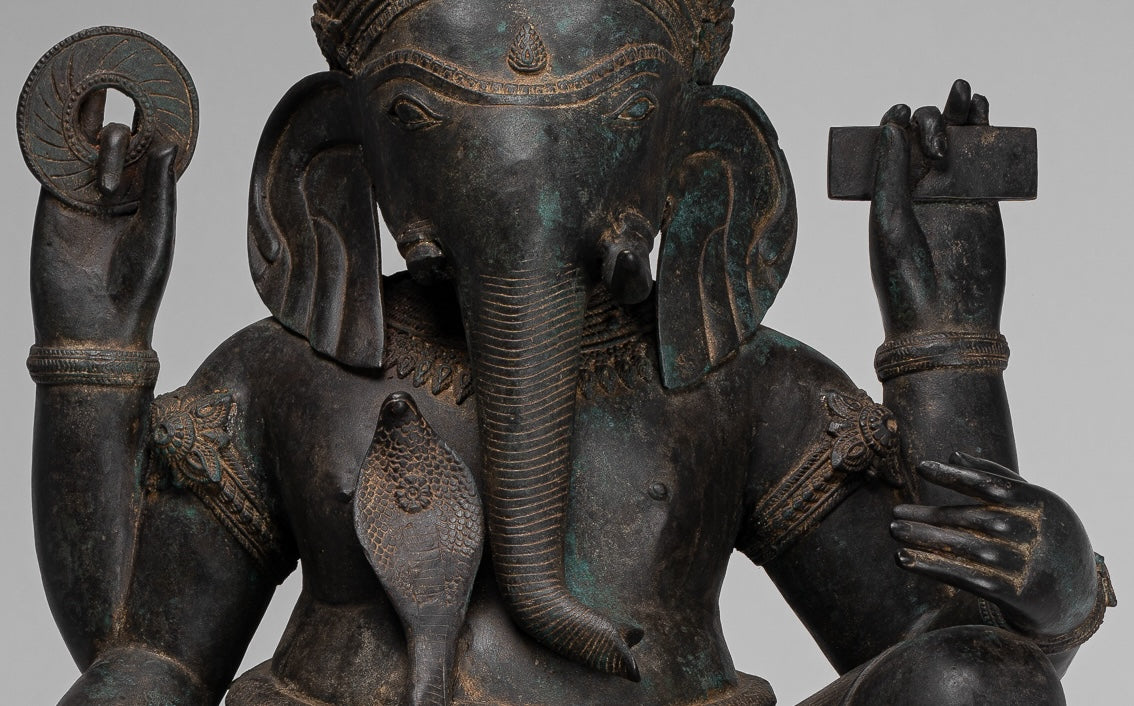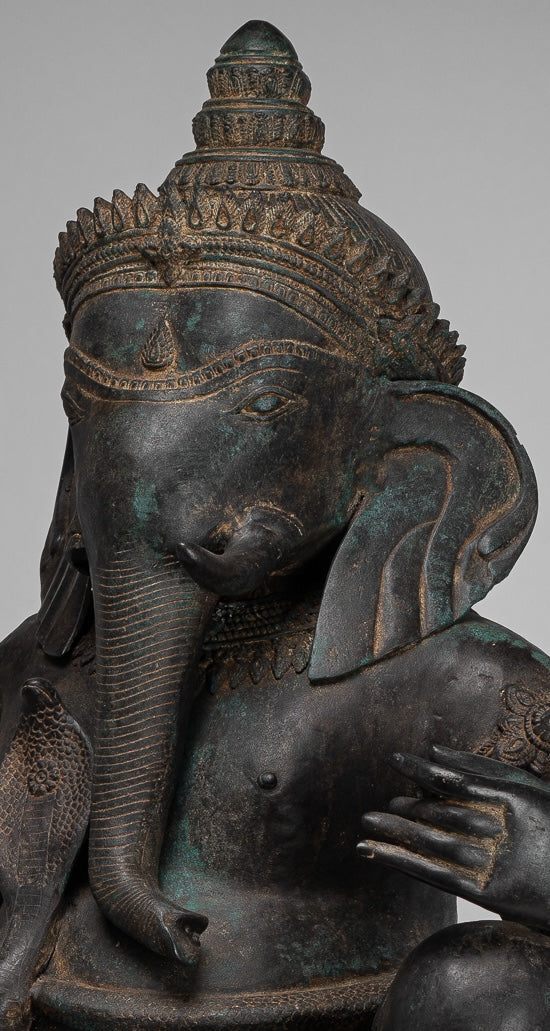-
Antique Thai Style Bronze Standing 4-Arm Ganesha Statue - 85cm/34"
Measures (Height) 85cm/34"
A magnificent, substantial, expressively cast antique Thai style bronze seated 4-arm Ganesha sat upon a simple plinth. In the intricate tapestry of Thai history and culture, the influence of Hinduism is unmistakable, permeating various aspects of society, religion, and tradition. Among the pantheon of Hindu deities, Lord Ganesh, the revered elephant-headed god, holds a special place in Thai hearts and minds.
The distinctive patina of the piece is particularly delightful. Ganesha is the elephant headed son of Shiva. He holds his chakra, broken tusk and sutra, in his hands.
In this depiction of Ganesha he also holds the remnants of his broken tusk. The breaking of the tusk has several backstories. One instance suggests that it was shattered when Shiva cut the head off the elephant, prior to bestowing it onto Ganesha. Another writes that Ganesha’s quill broke and he needed a writing instrument – try telling your boss that next time you try to write up a report with an elephant tusk because your computer crashed. Regardless of its multiple origins, the holding of the tusk represents less of a keepsake, and more of a depiction that our spirituality is more important than our outer bodies, meaning we must overcome the duality of the two as separate entities.
In the rich tapestry of Hindu iconography, Lord Ganesha stands as a symbol of wisdom, intellect, and the remover of obstacles. One of the intriguing and symbolic attributes often depicted in the imagery of Ganesha is his association with a sacred book or sutra.
In Hindu iconography, the book or sutra held by Ganesha represents the repository of sacred knowledge. It is symbolic of the scriptures, teachings, and the divine wisdom that guides seekers on the path of righteousness and self-realization. Ganesha's connection with the sacred book positions him as the guardian and custodian of knowledge. The deity is often invoked at the commencement of academic pursuits or any intellectual endeavor to seek blessings for success and clarity of thought. The book or sutra in Ganesha's hands serves as a guide on the path to self-realization. It represents the spiritual teachings that lead individuals toward understanding the true nature of the self and attaining a state of profound wisdom and enlightenment.
As he does here, Ganesha, the elephant-headed deity revered as the Remover of Obstacles, takes on a dynamic aspect when associated with the divine chakra. The chakra, a circular disc with spokes, is a potent symbol in Hinduism representing cosmic order, divine energy, and the eternal cycle of life. When held by Ganesha, the chakra takes on specific connotations that enrich the spiritual narrative. Ganesha holding a chakra symbolizes his connection to the cosmic wheel of creation. The chakra embodies the cyclical nature of existence, underscoring the perpetual dance of birth, life, death, and rebirth. Ganesha, as the Lord of Beginnings, is intricately linked to the eternal flow of cosmic energy.
The chakra in Ganesha's hand serves as a spiritual compass, guiding devotees on their journey toward self-realization. It signifies his role as a divine mentor, navigating seekers through the complexities of life and helping them overcome obstacles on the path to enlightenment. Ganesha holding a chakra is emblematic of his power to cut through karmic impediments. The chakra, as a symbol of cosmic order, aids in the dissolution of negative karmas, allowing individuals to move forward on their spiritual journey unburdened by past actions.
His fourth hand Ganesha holds in the dharmachakra mudra, a gesture of Teaching . In sanskrit dharmachakra means the 'Wheel of Dharma'. This circle represents the Wheel of Dharma, or in metaphysical terms, the union of method and wisdom.
The elephant-headed god is wearing a short dhoti with crossed cloth around his portly waist.
Ganesha is often found playing a musical instrument. Similar to Krishna Ganesha celebrates life through it's pleasures and beauty. The direction of Ganesha's trunk has symbolic meaning. Here the trunk turns to Ganesha's left.The direction of Ganesha's trunk has symbolic meaning. Here the trunk turns to Ganesha's left. This signifies the direction for success in the world. It is a position associated with grihastas, or householders.
In his early forms in India, Ganesha was associated with fertility. Later he became widely revered as the Remover of Obstacles and more generally as Lord of Beginnings and Lord of Obstacles, patron of arts and sciences and the deity of intellect and wisdom. One of the most recognizable of the Asian deities this representation of Ganesha is sure to enlighten your home with endlessly timeless style.
SATISFACTION GUARANTEE - We have been offering SE Asian Art for many years and are proud of the reputation we have developed for fair and honest listings. However, if for any reason, whatsoever, you are unhappy with your purchase please just let us know and we will provide a full refund. We want you to be 100% happy with your purchase.
-
The majority of orders will be shipped with DHL. This is a secure, express and fully tracked service.
Items less than 2Kg we typically ship using Royal Mail.
Once we receive your order we try to ship all orders the same or next working day.
Large and/or fragile pieces requiring palletising, specialist crating and/or extra packaging may take a little longer. Palletised shipments will be delivered curbside.
All orders over 35 GBP will be shipped free of charge.

-
We genuinely hope that all purchases delight.
However, if they do not, regardless of reason, we will refund all orders upon receipt of the unwanted item. Just notify us within 14 days of receiving your order that you wish to make a return and send the piece back to us with 30 days of delivery.
Let Us Help You Find The Piece You Desire
Let Us Help You Find The Piece You Desire
Buddha just received. Beautiful indeed.
François, Paris, France
The elephant arrived today—it is lovely!!! Thank you!
Christopher, Washington, DC, USA
I received Buddha today. It is perfect and has a home on my mantle. Love it!
Jennifer, Minneapolis, MN, USA




























































































